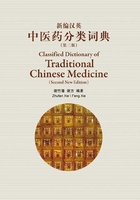
Foreword II
With extraordinary persistence, thorough knowledge of both western and traditional Chinese medicine (TCM), and deep insight into future trend of healthcare, Prof. Zhufan Xie has made tremendous contributions in the field of integration of TCM and western medicine. Not only has he established and directed the Department of Integrative Medicine in Peking University First Hospital, he also founded and promoted this emerging and up-rising medicine nationwide. His exceptional achievements in promoting the communication between the East and West and standardizing the translation of TCM terminologies have made him the pioneer in elucidating TCM to the world. Prof. Xie has been attaching great importance to the standardization of English translation of TCM terminologies since he entered the profession of integrative medicine and international communication. Having authored several TCM English dictionaries, he is well recognized as the core leader in the field of English translation of TCM terminologies.
The first new edition of Classified Dictionary of Traditional Chinese Medicine, published in September 2002, has won immense praise from practitioners of TCM and integrative medicine, especially those who were engaged in TCM international communication. It was assigned as the main reference book for the International Standard Terminologies on Traditional Medicine in the Western Pacific Region by the World Health Organization (WHO) in 2007. Subsequently, the World Federation of Chinese Medicine Societies invited Prof. Xie along with many other experts worldwide to compile the International Standard Chinese-English Basic Nomenclature of Chinese Medicine. As a chairman of the revising-approving committee, Prof. Xie was responsible to proofread every single entry and the Dictionary was referred to most frequently. For his exceptional contributions, Prof. Xie was praised by the WHO as “the leading core among the experts” in making it possible for WHO/WPRO to publish the aforementioned book on terminologies. He was also awarded as the honorary chairman of the first translation committee of the World Federation of Chinese Medicine Societies.
The experiences of preparing these two international standards have also given Prof. Xie the opportunities to re-evaluate the Dictionary. Since then, Prof. Xie has been working on how to correct or modify some individual entries that seem not appropriate, how to make an expression easier to catch, and how to meet the demand of the readers and make it up-to-date. Now that the Dictionary is sold out and ready to be reprinted, he has timely completed the revision of the Dictionary with the assistance of our visiting Prof. Fang Xie. 944 entries have been added, making a total of 8,330; the translations of some entries have been updated to make them more in line with the current national and international standards. The interpretation of each term was reviewed word for word and necessary modifications were made; the entries of common citations were increased from the original 376 to 450, each of which was carefully worded to make sure that it is reflective of the original idea, easy to understand and easy to read, so as to make it as much reader-friendly as possible.
It is noteworthy that a new feature is added by building the appendix of meanings, translations and illustrations of commonly used words in TCM. The translation of a TCM term is closely related to the meaning of the Chinese characters that construct the term. For example, the character “焦” of the term “三焦” is in fact a varied form of the character “膲” which means the body cavity and the internal organs within. Thus it has nothing to do with the meaning of “excessive fire to make things burn into carbon”. Obviously, either “burner” or “heater” is an inappropriate term to interpret “焦”. For another example, the character “能” is a varied form of “態” in archaic Chinese. So when “病能” is replaced by “病态”, the translation of the former is clearer. For other examples, the translation of “人中” into philtrum and the translation of “人迎” into carotid artery become more distinct when the related characters are explained. As for why the same character can be translated differently in different words or phrases, the appendix also provides clear and proper explanations.
Classification of chapters by subjects is maintained in the second new edition, making it both a dictionary and a concise encyclopedia of Chinese medicine.
The publication of the second new edition demonstrates the timely updating of English translation standards of TCM terminology. It is also the embodiment of Prof. Xie's academic spirit of persistence and diligence. The second new edition provides not only a detailed, accurate and practical reference book for domestic and foreign medical practitioners as well as those who are interested in international communication of TCM, but also a great tool for the promotion of communication between Chinese and Western medicine in the new era.
Xuezhi Zhang
Institute of Integrative Medicine, Peking University
Xie Zhufan Studio of “Inheritance Program of TCM Veteran” of
Beijing Traditional Chinese Medicine Administration